The Antigenic Membrane Protein (Amp) of Rice Orange Leaf Phytoplasma Suppresses Host Defenses and Is Involved in Pathogenicity
Abstract
1. Introduction
2. Results
2.1. Identification of Amp Encoded by ROLP
2.2. Expression Characteristics of ROLP Encoded Amp in Rice and R. dorsalis
2.3. Amp Promotes the Proliferation of ROLP in Rice Plants
2.4. Amp Suppressed Host Defense Responses through SA and Ethylene Biosynthesis
2.5. Amp Enhances PVX Virulence in Tobacco
3. Discussion
4. Materials and Methods
4.1. Plant Materials
4.2. Phytoplasma and Insects
4.3. Generation of Amp Transgenic Lines
4.4. Quantitative Real-Time PCR
4.5. Y2H Assay
4.6. GST Pull-Down Assay
4.7. Western Blot
4.8. PVX Infection Assays
4.9. DAB and Trypan Blue Staining Assays
4.10. Statistical Analyses
5. Conclusions
Supplementary Materials
Author Contributions
Funding
Data Availability Statement
Acknowledgments
Conflicts of Interest
Abbreviations
| Amp | Antigenic membrane protein |
| A. tumefaciens | Agrobacterium tumefaciens |
| CP | Coat protein |
| CYP | Chrysanthemum yellow phytoplasma |
| DAB | Diaminobenzidine |
| ET | Ethylene |
| ETI | Effector-triggered immunity |
| E. variegatus | Euscelidius variegatus |
| HR | Hypersensitive response |
| IDP | Immunodominant membrane protein |
| Imp | Immunodominant membrane protein |
| IdpA | Immunodominant membrane protein A |
| N. benthamiana | Nicotiana benthamiana |
| N. cincticeps | Nephotettix cinticeps |
| OY | Onion yellow strain |
| OY-M | Onion yellow strain, a mildly pathogenic line |
| PTI | PAMP-triggered immunity |
| PVX | Potato virus X |
| ROLP | Rice orange leaf phytoplasma |
| R. dorsalis | Recilia dorsalis |
| SA | Salicylic acid |
| Sec | Secretion pathway. |
References
- Lee, I.M.; Davis, R.E.; Gundersenrindal, D.E. Phytoplasma: Phytopathogenic Mollicutes. Annu. Rev. Microbiol. 2000, 54, 221–225. [Google Scholar] [CrossRef] [PubMed]
- Sugio, A.; MacLean, A.M.; Kingdom, H.N.; Grieve, V.M.; Manimekalai, R.; Hogenhout, S.A. Diverse Targets of Phytoplasma Effectors: From Plant Development to Defense Against Insects. Annu. Rev. Phytopathol. 2011, 49, 175–195. [Google Scholar] [CrossRef] [PubMed]
- Hogenhout, S.A.; Oshima, K.; Ammar, E.-D.; Kakizawa, S.; Kingdom, H.N.; Namba, S. Phytoplasmas: Bacteria that manipulate plants and insects. Mol. Plant Pathol. 2008, 9, 403–423. [Google Scholar] [CrossRef] [PubMed]
- Bai, X.; Correa, V.R.; Toruño, T.Y.; Ammar, E.-D.; Kamoun, S.; Hogenhout, S.A. AY-WB Phytoplasma Secretes a Protein That Targets Plant Cell Nuclei. Mol. Plant-Microbe Interact. 2009, 22, 18–30. [Google Scholar] [CrossRef]
- Strauss, E. Phytoplasma Research Begins to Bloom. Science 2009, 325, 388–390. [Google Scholar] [CrossRef] [PubMed]
- Kakizawa, S.; Oshima, K.; Nishigawa, H.; Jung, H.-Y.; Wei, W.; Suzuki, S.; Tanaka, M.; Miyata, S.-I.; Ugaki, M.; Namba, S. Secretion of immunodominant membrane protein from onion yellows phytoplasma through the Sec protein-translocation system in Escherichia coli. Microbiology 2004, 150, 135–142. [Google Scholar] [CrossRef] [PubMed]
- Kakizawa, S.; Oshima, K.; Ishii, Y.; Hoshi, A.; Maejima, K.; Jung, H.-Y.; Yamaji, Y.; Namba, S. Cloning of immunodominant membrane protein genes of phytoplasmas and theirin planta expression. FEMS Microbiol. Lett. 2009, 293, 92–101. [Google Scholar] [CrossRef]
- Aurin, M.-B.; Haupt, M.; Görlach, M.; Rümpler, F.; Theißen, G. Structural Requirements of the Phytoplasma Effector Protein SAP54 for Causing Homeotic Transformation of Floral Organs. Mol. Plant-Microbe Interact. 2020, 33, 1129–1141. [Google Scholar] [CrossRef]
- Huang, W.; MacLean, A.M.; Sugio, A.; Maqbool, A.; Busscher, M.; Cho, S.-T.; Kamoun, S.; Kuo, C.-H.; Immink, R.G.H.; Hogenhout, S.A. Parasitic modulation of host development by ubiquitin-independent protein degradation. Cell 2021, 184, 5201–5214.e12. [Google Scholar] [CrossRef]
- Kube, M.; Schneider, B.; Kuhl, H.; Dandekar, T.; Heitmann, K.; Migdoll, A.M.; Reinhardt, R.; Seemüller, E. The linear chromosome of the plant-pathogenic mycoplasma ‘Candidatus Phytoplasma mali’. BMC Genomics 2008, 9, 306. [Google Scholar] [CrossRef]
- Alavi, Y.; Arai, M.; Mendoza, J.; Tufet-Bayona, M.; Sinha, R.; Fowler, K.; Billker, O.; Franke-Fayard, B.; Janse, C.J.; Waters, A.; et al. The dynamics of interactions between Plasmodium and the mosquito: A study of the infectivity of Plasmodium berghei and Plasmodium gallinaceum, and their transmission by Anopheles stephensi, Anopheles gambiae and Aedes aegypti. Int. J. Parasitol. 2003, 33, 933–943. [Google Scholar] [CrossRef]
- Gratz, N.G. Emerging and resurging vector-borne diseases. Annu. Rev. Entomol. 1999, 44, 51–75. [Google Scholar] [CrossRef]
- Yu, Y.; Yeh, K.; Lin, C. An antigenic protein gene of a phytoplasma associated with sweet potato witches’ broom. Microbiology 1998, 144, 1257–1262. [Google Scholar] [CrossRef] [PubMed]
- Kakizawa, S.; Oshima, K.; Namba, S. Diversity and functional importance of phytoplasma membrane proteins. Trends Microbiol. 2006, 14, 254–256. [Google Scholar] [CrossRef] [PubMed]
- Konnerth, A.; Krczal, G.; Boonrod, K. Immunodominant membrane proteins of phytoplasmas. Microbiology 2016, 162, 1267–1273. [Google Scholar] [CrossRef]
- Morton, A.; Davies, D.L.; Blomquist, C.L.; Barbara, D.J. Characterization of homologues of the apple proliferation immunodominant membrane protein gene from three related phytoplasmas. Mol. Plant Pathol. 2003, 4, 109–114. [Google Scholar] [CrossRef] [PubMed]
- Siampour, M.; Izadpanah, K.; Galetto, L.; Salehi, M.; Marzachí, C. Molecular characterization, phylogenetic comparison and serological relationship of the Imp protein of several ‘Candidatus Phytoplasma aurantifolia’ strains. Plant Pathol. 2013, 62, 452–459. [Google Scholar] [CrossRef]
- Boonrod, K.; Munteanu, B.; Jarausch, B.; Jarausch, W.; Krczal, G. An Immunodominant Membrane Protein (Imp) of ‘Candidatus Phytoplasma mali’ Binds to Plant Actin. Mol. Plant-Microbe Interact. 2012, 25, 889–895. [Google Scholar] [CrossRef]
- Blomquist, C.L.; Barbara, D.J.; Davies, D.L.; Clark, M.F.; Kirkpatrick, B.C. An immunodominant membrane protein gene from the Western X-disease phytoplasma is distinct from those of other phytoplasmas. Microbiology 2001, 147, 571–580. [Google Scholar] [CrossRef]
- Neriya, Y.; Sugawara, K.; Maejima, K.; Hashimoto, M.; Komatsu, K.; Minato, N.; Miura, C.; Kakizawa, S.; Yamaji, Y.; Oshima, K.; et al. Cloning, expression analysis, and sequence diversity of genes encoding two different immunodominant membrane proteins in poinsettia branch-inducing phytoplasma (PoiBI). FEMS Microbiol. Lett. 2011, 324, 38–47. [Google Scholar] [CrossRef]
- Barbara, D.J.; Morton, A.; Clark, M.F.; Davies, D.L. Immunodominant membrane proteins from two phytoplasmas in the aster yellows clade (chlorante aster yellows and clover phyllody) are highly divergent in the major hydrophilic region. Microbiology 2002, 148, 157–167. [Google Scholar] [CrossRef]
- Arricau-Bouvery, N.; Duret, S.; Dubrana, M.-P.; Batailler, B.; Desque, D.; Beven, L.; Danet, J.-L.; Monticone, M.; Bosco, D.; Malembic-Maher, S.; et al. Variable Membrane Protein A of Flavescence Doree Phytoplasma Binds the Midgut Perimicrovillar Membrane of Euscelidius variegatus and Promotes Adhesion to Its Epithelial Cells. Appl. Environ. Microbiol. 2018, 84, e02487-17. [Google Scholar] [CrossRef]
- Arricau-Bouvery, N.; Duret, S.; Dubrana, M.-P.; Desque, D.; Eveillard, S.; Brocard, L.; Malembic-Maher, S.; Foissac, X. Interactions between the flavescence doree phytoplasma and its insect vector indicate lectin-type adhesion mediated by the adhesin VmpA. Sci. Rep. 2021, 11, 11222. [Google Scholar] [CrossRef] [PubMed]
- Cimerman, A.; Pacifico, D.; Salar, P.; Marzachì, C.; Foissac, X. Striking Diversity of vmp1, a Variable Gene Encoding a Putative Membrane Protein of the Stolbur Phytoplasma. Appl. Environ. Microbiol. 2009, 75, 2951–2957. [Google Scholar] [CrossRef]
- Suzuki, S.; Oshima, K.; Kakizawa, S.; Arashida, R.; Jung, H.-Y.; Yamaji, Y.; Nishigawa, H.; Ugaki, M.; Namba, S. Interaction between the membrane protein of a pathogen and insect microfilament complex determines insect-vector specificity. Proc. Natl. Acad. Sci. USA 2006, 103, 4252–4257. [Google Scholar] [CrossRef] [PubMed]
- Bosco, D.; Galetto, L.; Leoncini, P.; Saracco, P.; Raccah, B.; Marzachì, C. Interrelationships Between “Candidatus Phytoplasma asteris” and Its Leafhopper Vectors (Homoptera: Cicadellidae). J. Econ. Entomol. 2007, 100, 1504–1511. [Google Scholar] [CrossRef] [PubMed]
- Galetto, L.; Bosco, D.; Balestrini, R.; Genre, A.; Fletcher, J.; Marzachì, C. The Major Antigenic Membrane Protein of “Candidatus Phytoplasma asteris” Selectively Interacts with ATP Synthase and Actin of Leafhopper Vectors. PLoS ONE 2011, 6, e22571. [Google Scholar] [CrossRef]
- Li, S.; Hao, W.; Lu, G.; Huang, J.; Liu, C.; Zhou, G. Occurrence and Identification of a New Vector of Rice Orange Leaf Phytoplasma in South China. Plant Dis. 2015, 99, 1483–1487. [Google Scholar] [CrossRef]
- Hoshi, A.; Oshima, K.; Kakizawa, S.; Ishii, Y.; Ozeki, J.; Hashimoto, M.; Komatsu, K.; Kagiwada, S.; Yamaji, Y.; Namba, S. A unique virulence factor for proliferation and dwarfism in plants identified from a phytopathogenic bacterium. Proc. Natl. Acad. Sci. USA 2009, 106, 6416–6421. [Google Scholar] [CrossRef]
- Valarmathi, P.; Rabindran, R.; Velazhahan, R.; Suresh, S.; Robin, S. First report of Rice orange leaf disease phytoplasma (16 SrI) in rice (Oryza sativa) in India. Plant Dis. 2013, 1, 141–143. [Google Scholar] [CrossRef]
- Zhu, Y.; He, Y.; Zheng, Z.; Chen, J.; Wang, Z.; Zhou, G. Draft Genome Sequence of Rice Orange Leaf Phytoplasma from Guangdong, China. Genome Announc. 2017, 5, e00430-17. [Google Scholar] [CrossRef] [PubMed]
- Zhang, X.; Ji, Z.; Huang, Z.; Zhao, Y.; Wang, H.; Jiang, Z.; Li, Z.; Chen, H.; Chen, W.; Wei, T. Detection and characterization of rice orange leaf phytoplasma infection in rice and Recilia dorsalis. Phytopathol. Res. 2022, 4, 34. [Google Scholar] [CrossRef]
- Liu, Z.-Q.; Liu, Y.-Y.; Shi, L.-P.; Yang, S.; Shen, L.; Yu, H.-X.; Wang, R.-Z.; Wen, J.-Y.; Tang, Q.; Hussain, A.; et al. SGT1 is required in PcINF1/SRC2-1 induced pepper defense response by interacting with SRC2-1. Sci. Rep. 2016, 6, 21651. [Google Scholar] [CrossRef] [PubMed]
- Jirage, D.; Tootle, T.L.; Reuber, T.L.; Frost, L.N.; Feys, B.J.; Parker, J.E.; Ausubel, F.M.; Glazebrook, J. Arabidopsis thaliana PAD4 encodes a lipase-like gene that is important for salicylic acid signaling. Proc. Natl. Acad. Sci. USA 1999, 96, 13583–13588. [Google Scholar] [CrossRef] [PubMed]
- Ke, Y.; Liu, H.; Li, X.; Xiao, J.; Wang, S. Rice OsPAD4 functions differently from Arabidopsis AtPAD4 in host-pathogen interactions. Plant J. 2014, 78, 619–631. [Google Scholar] [CrossRef]
- Lu, G.; Zhang, T.; He, Y.; Zhou, G. Virus altered rice attractiveness to planthoppers is mediated by volatiles and related to virus titre and expression of defence and volatile-biosynthesis genes. Sci. Rep. 2016, 6, 38581. [Google Scholar] [CrossRef]
- Ali, S.; Ganai, B.A.; Kamili, A.N.; Bhat, A.A.; Mir, Z.A.; Bhat, J.A.; Tyagi, A.; Islam, S.T.; Mushtaq, M.; Yadav, P.; et al. Pathogenesis-related proteins and peptides as promising tools for engineering plants with multiple stress tolerance. Microbiol. Res. 2018, 212–213, 29–37. [Google Scholar] [CrossRef]
- Zhao, H.; Duan, K.-X.; Ma, B.; Yin, C.-C.; Hu, Y.; Tao, J.-J.; Huang, Y.-H.; Cao, W.-Q.; Chen, H.; Yang, C.; et al. Histidine kinase MHZ1/OsHK1 interacts with ethylene receptors to regulate root growth in rice. Nat. Commun. 2020, 11, 518. [Google Scholar] [CrossRef]
- Makarova, O.; MacLean, A.M.; Nicolaisen, M. Phytoplasma adapt to the diverse environments of their plant and insect hosts by altering gene expression. Physiol. Mol. Plant Pathol. 2015, 91, 81–87. [Google Scholar] [CrossRef]
- Oshima, K.; Ishii, Y.; Kakizawa, S.; Sugawara, K.; Neriya, Y.; Himeno, M.; Minato, N.; Miura, C.; Shiraishi, T.; Yamaji, Y. Dramatic Transcriptional Changes in an Intracellular Parasite Enable Host Switching between Plant and Insect. PLoS ONE 2011, 6, e23242. [Google Scholar] [CrossRef]
- Mittelberger, C.; Stellmach, H.; Hause, B.; Kerschbamer, C.; Schlink, K.; Letschka, T.; Janik, K. A Novel Effector Protein of Apple Proliferation Phytoplasma Disrupts Cell Integrity of Nicotiana spp. Protoplasts. Int. J. Mol. Sci. 2019, 20, 4613. [Google Scholar] [CrossRef] [PubMed]
- Dodds, P.N.; Rathjen, J.P. Plant immunity: Towards an integrated view of plant–pathogen interactions. Nat. Rev. Genet. 2010, 11, 539–548. [Google Scholar] [CrossRef]
- Sugio, A.; Kingdom, H.N.; MacLean, A.M.; Grieve, V.M.; Hogenhout, S.A. Phytoplasma protein effector SAP11 enhances insect vector reproduction by manipulating plant development and defense hormone biosynthesis. Proc. Natl. Acad. Sci. USA 2011, 108, E1254–E1263. [Google Scholar] [CrossRef]
- Marcone, C. Molecular biology and pathogenicity of phytoplasmas. Ann. Appl. Biol. 2014, 165, 199–221. [Google Scholar] [CrossRef]
- Wang, X.; Luo, C.; Xu, Y.; Zhang, C.; Bao, M.; Dou, J.; Wang, Q.; Cheng, Y. Expression of the p24 silencing suppressor of Grapevine leafroll-associated virus 2 from Potato virus X or Barley stripe mosaic virus vector elicits hypersensitive responses in Nicotiana benthamiana. Plant Physiol. Biochem. 2019, 142, 34–42. [Google Scholar] [CrossRef]
- Murray, M.G.; Thompson, W.F. Rapid isolation of high molecular weight plant DNA. Nucleic Acids Res. 1980, 8, 4321–4326. [Google Scholar] [CrossRef]
- Wang, Z.; Zhu, Y.; Li, Z.; Yang, X.; Zhang, T.; Zhou, G. Development of a Specific Polymerase Chain Reaction System for the Detection of Rice Orange Leaf Phytoplasma. Plant Dis. 2020, 104, 521–526. [Google Scholar] [CrossRef]
- Zhu, H.; Hu, F.; Wang, R.; Zhou, X.; Sze, S.-H.; Liou, L.W.; Barefoot, A.; Dickman, M.; Zhang, X. Arabidopsis Argonaute10 Specifically Sequesters miR166/165 to Regulate Shoot Apical Meristem Development. Cell 2011, 145, 242–256. [Google Scholar] [CrossRef] [PubMed]
- Hiei, Y.; Ohta, S.; Komari, T.; Kumashiro, T. Efficient transformation of rice (Oryza sativa L.) mediated by Agrobacterium and sequence analysis of the boundaries of the T-DNA. Plant J. 1994, 6, 271–282. [Google Scholar] [CrossRef]
- Shao, J.; Jomantienė, R.; Dally, E.L.; Zhao, Y.; Lee, I.-M.; Nuss, D.L.; Davis, R.E. Phylogeny and characterization of phytoplasmal nusA and use of the nusA gene in detection of group 16SrI strains. J. Plant Pathol. 2006, 88, 193–201. [Google Scholar]
- Schmittgen, T.D.; Livak, K.J. Analyzing real-time PCR data by the comparative C-T method. Nat. Protoc. 2008, 3, 1101–1108. [Google Scholar] [CrossRef] [PubMed]
- Zhao, Y.; Cao, X.; Zhong, W.; Zhou, S.; Li, Z.; An, H.; Liu, X.; Wu, R.; Bohora, S.; Wu, Y.; et al. A viral protein orchestrates rice ethylene signaling to coordinate viral infection and insect vector-mediated transmission. Mol. Plant 2022, 15, 689–705. [Google Scholar] [CrossRef] [PubMed]
- Chapman, S.; Kavanagh, T.; Baulcombe, D. Potato virus X as a vector for gene expression in plants. Plant J. 1992, 2, 549–557. [Google Scholar] [CrossRef] [PubMed]
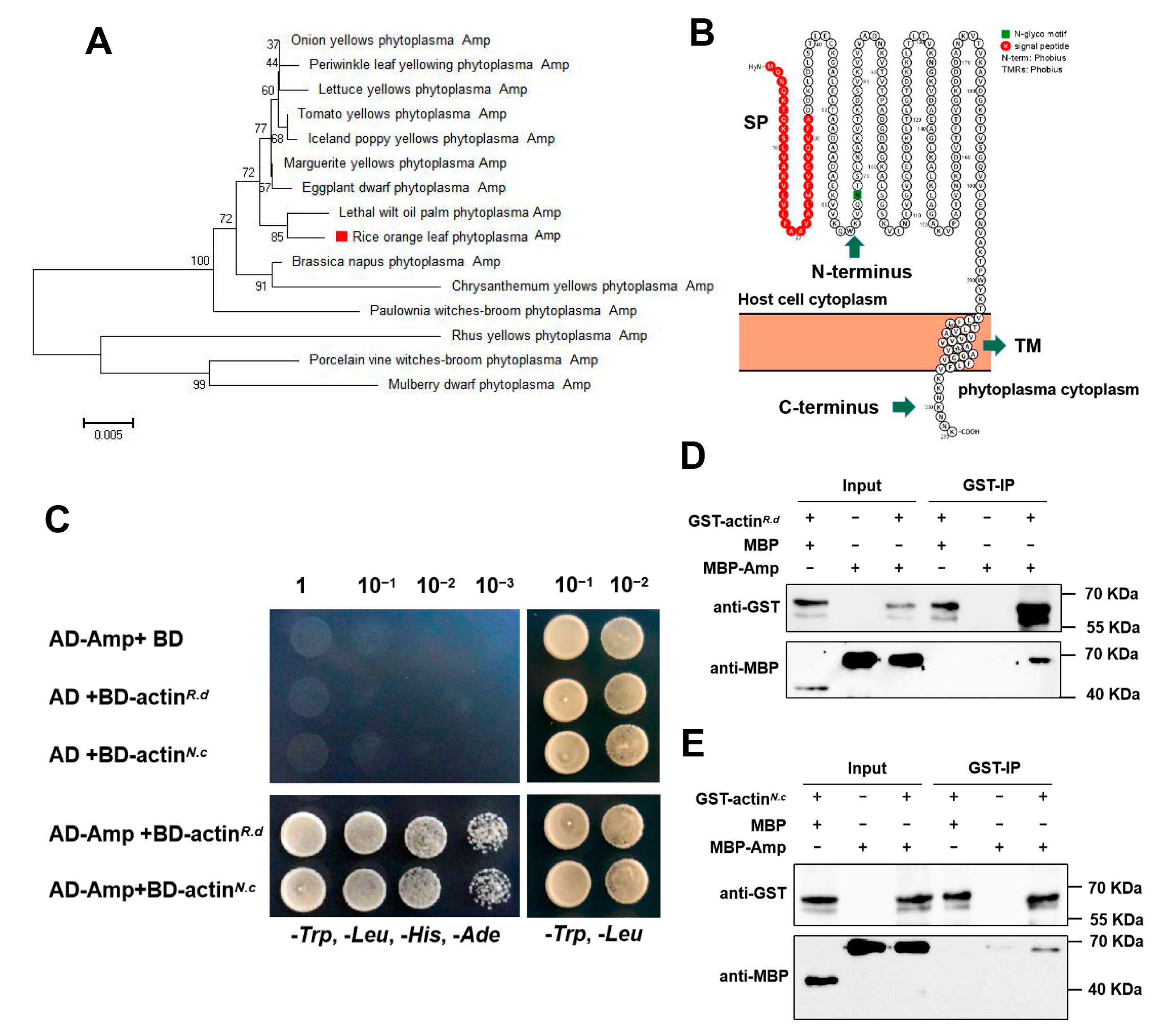
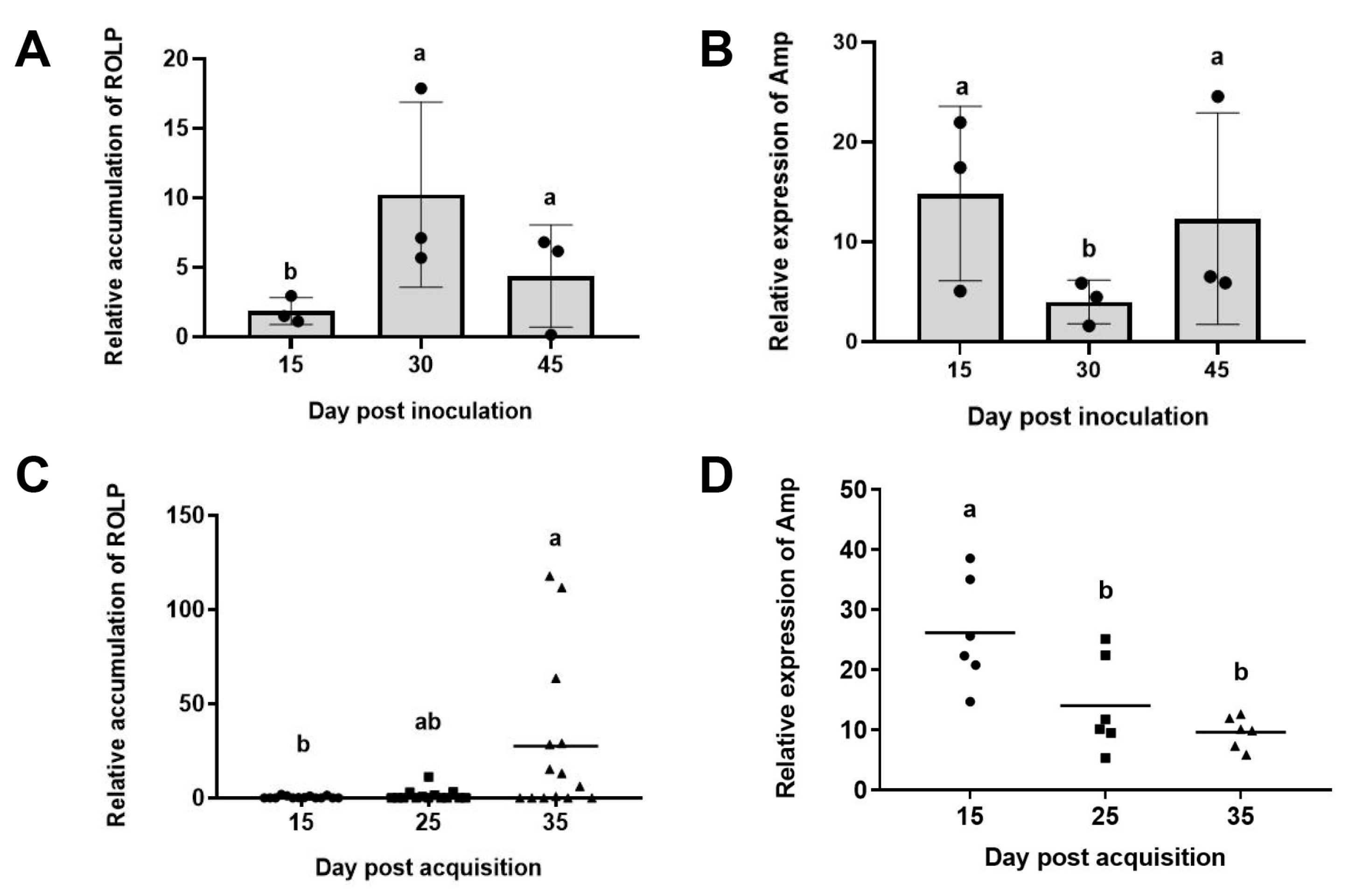
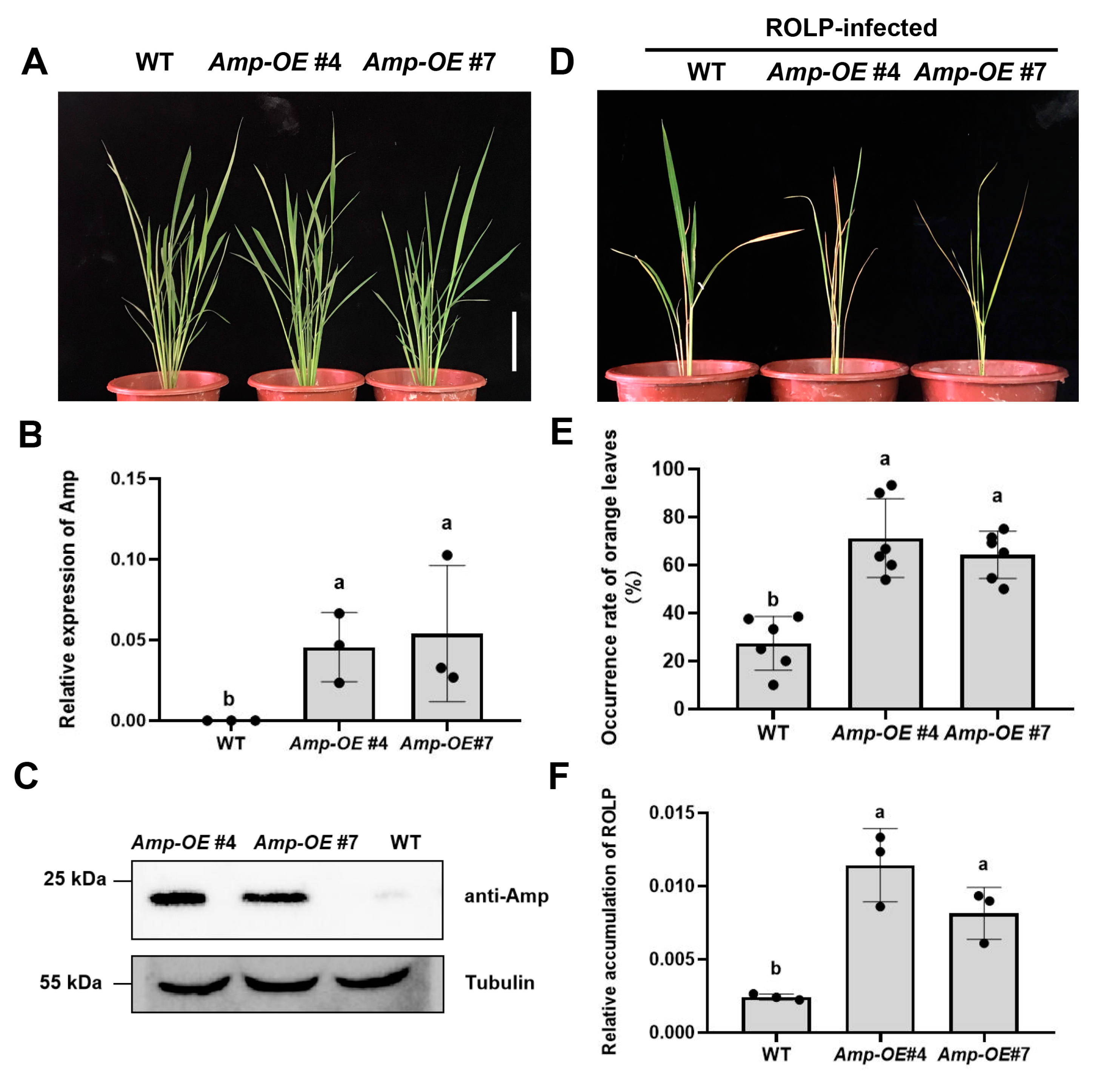
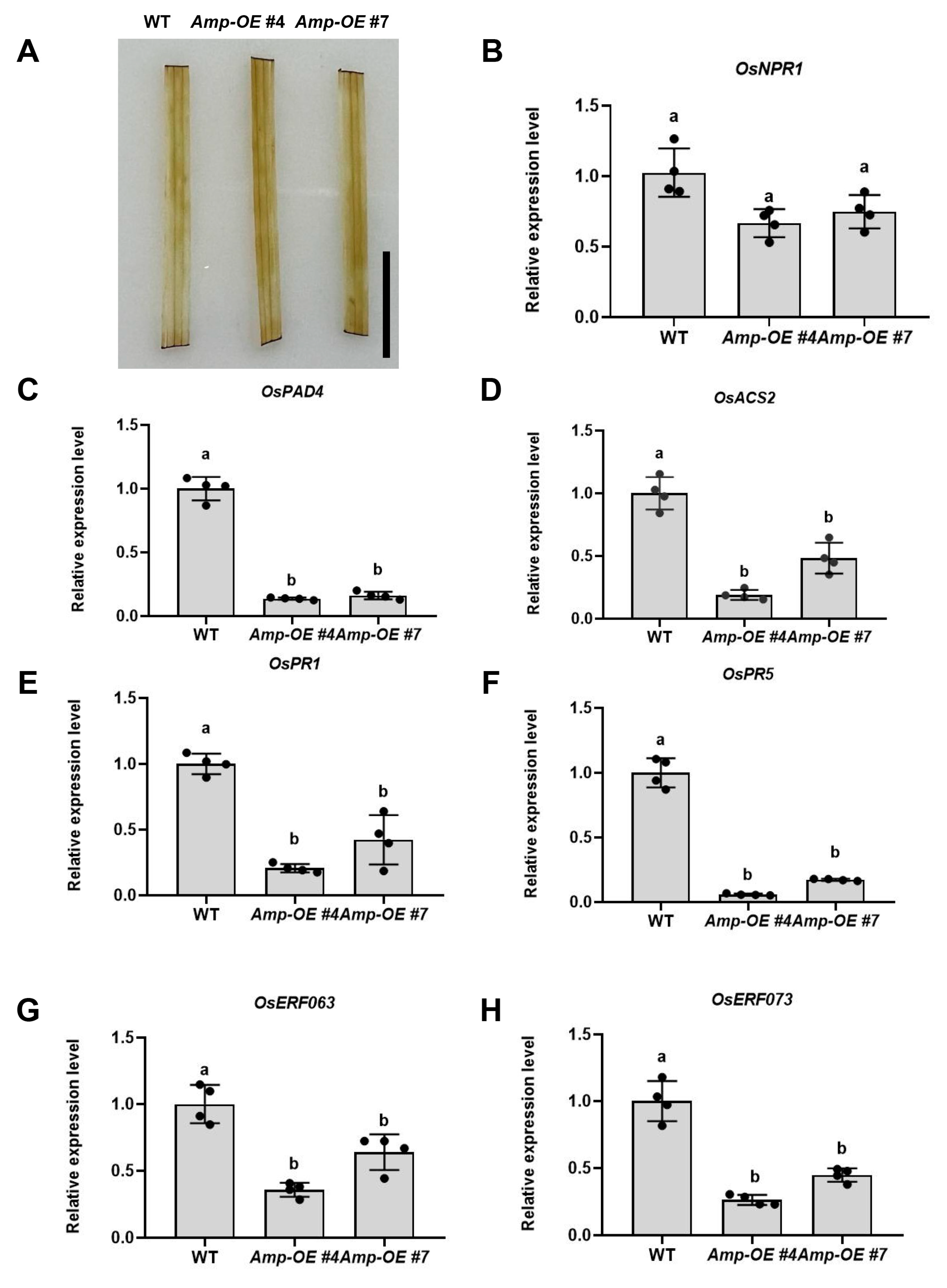
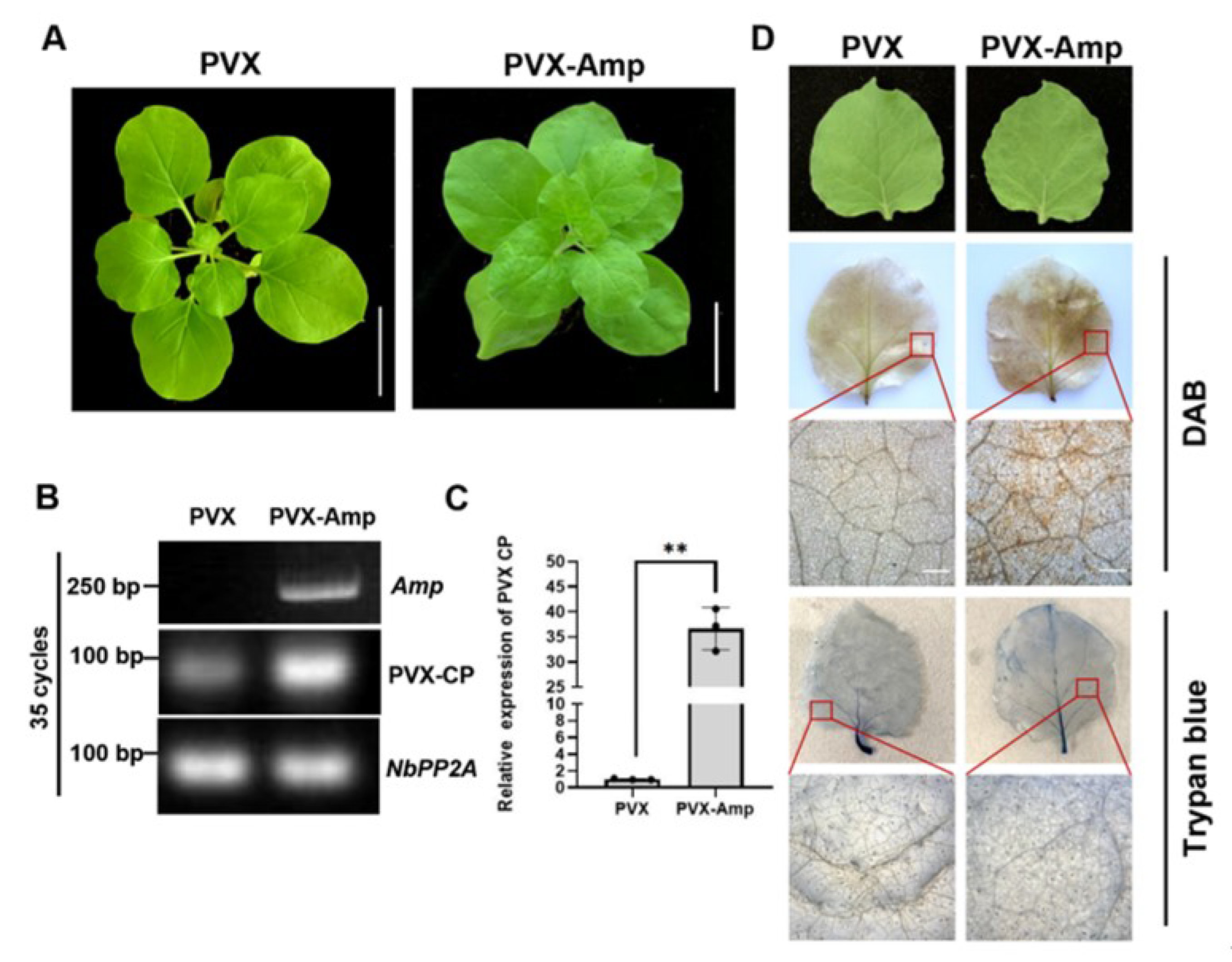
Disclaimer/Publisher’s Note: The statements, opinions and data contained in all publications are solely those of the individual author(s) and contributor(s) and not of MDPI and/or the editor(s). MDPI and/or the editor(s) disclaim responsibility for any injury to people or property resulting from any ideas, methods, instructions or products referred to in the content. |
© 2023 by the authors. Licensee MDPI, Basel, Switzerland. This article is an open access article distributed under the terms and conditions of the Creative Commons Attribution (CC BY) license (https://creativecommons.org/licenses/by/4.0/).
Share and Cite
Wang, Z.; Yang, X.; Zhou, S.; Zhang, X.; Zhu, Y.; Chen, B.; Huang, X.; Yang, X.; Zhou, G.; Zhang, T. The Antigenic Membrane Protein (Amp) of Rice Orange Leaf Phytoplasma Suppresses Host Defenses and Is Involved in Pathogenicity. Int. J. Mol. Sci. 2023, 24, 4494. https://doi.org/10.3390/ijms24054494
Wang Z, Yang X, Zhou S, Zhang X, Zhu Y, Chen B, Huang X, Yang X, Zhou G, Zhang T. The Antigenic Membrane Protein (Amp) of Rice Orange Leaf Phytoplasma Suppresses Host Defenses and Is Involved in Pathogenicity. International Journal of Molecular Sciences. 2023; 24(5):4494. https://doi.org/10.3390/ijms24054494
Chicago/Turabian StyleWang, Zhiyi, Xiaorong Yang, Siqi Zhou, Xishan Zhang, Yingzhi Zhu, Biao Chen, Xiuqin Huang, Xin Yang, Guohui Zhou, and Tong Zhang. 2023. "The Antigenic Membrane Protein (Amp) of Rice Orange Leaf Phytoplasma Suppresses Host Defenses and Is Involved in Pathogenicity" International Journal of Molecular Sciences 24, no. 5: 4494. https://doi.org/10.3390/ijms24054494
APA StyleWang, Z., Yang, X., Zhou, S., Zhang, X., Zhu, Y., Chen, B., Huang, X., Yang, X., Zhou, G., & Zhang, T. (2023). The Antigenic Membrane Protein (Amp) of Rice Orange Leaf Phytoplasma Suppresses Host Defenses and Is Involved in Pathogenicity. International Journal of Molecular Sciences, 24(5), 4494. https://doi.org/10.3390/ijms24054494




